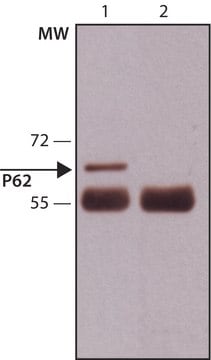P0067
Anti-p62/SQSTM1 antibody produced in rabbit
~1 mg/mL, affinity isolated antibody, buffered aqueous solution
Synonim(y):
Anti-Sequestosome 1, Anti-Ubiquitin-binding p62
About This Item
Polecane produkty
pochodzenie biologiczne
rabbit
białko sprzężone
unconjugated
forma przeciwciała
affinity isolated antibody
rodzaj przeciwciała
primary antibodies
klon
polyclonal
Postać
buffered aqueous solution
masa cząsteczkowa
antigen ~62 kDa
reaktywność gatunkowa
human, rat, mouse
opakowanie
antibody small pack of 25 μL
stężenie
~1 mg/mL
metody
immunoprecipitation (IP): 1-2 μg using lysate of NIH-3T3 cells
indirect immunofluorescence: 1-2 μg/mL using human A549 cells
western blot: 1-2 μg/mL using whole extracts of rat PC12 cells
numer dostępu UniProt
Warunki transportu
dry ice
temp. przechowywania
−20°C
docelowa modyfikacja potranslacyjna
unmodified
informacje o genach
human ... SQSTM1(8878)
mouse ... Sqstm1(18412)
rat ... Sqstm1(113894)
Powiązane kategorie
Opis ogólny
Anti-p62/SQSTM1 is produced in rabbit using as immunogen a synthetic peptide corresponding to amino acids of human p62/SQSTM1 (GeneID: 8878), conjugated to KLH. The corresponding sequence is identical in rat and mouse. The antibody is affinity-purified using the immunizing peptide immobilized on agarose.
Specyficzność
Immunogen
Zastosowanie
- western blotting
- immunoprecipitation in human cell lines
- Immunohistochemistry prostatectomy specimens
Działania biochem./fizjol.
Mutations in this gene result in sporadic and familial Paget disease of bone. p62 is commonly found in inclusion bodies containing polyubiquitinated protein aggregates, that accumulate in several degenerative diseases. Autophagy is involved in cellular clearance of these protein aggregates. Autophagy plays an essential role in cellular differentiation, cell death, and aging. Defective autophagy may contribute to certain human diseases such as cancer, neurodegenerative diseases, muscular disorders, and pathogen infections.
Postać fizyczna
Przechowywanie i stabilność
Oświadczenie o zrzeczeniu się odpowiedzialności
Not finding the right product?
Try our Narzędzie selektora produktów.
Kod klasy składowania
10 - Combustible liquids
Temperatura zapłonu (°F)
Not applicable
Temperatura zapłonu (°C)
Not applicable
Środki ochrony indywidualnej
Eyeshields, Gloves, multi-purpose combination respirator cartridge (US)
Certyfikaty analizy (CoA)
Poszukaj Certyfikaty analizy (CoA), wpisując numer partii/serii produktów. Numery serii i partii można znaleźć na etykiecie produktu po słowach „seria” lub „partia”.
Masz już ten produkt?
Dokumenty związane z niedawno zakupionymi produktami zostały zamieszczone w Bibliotece dokumentów.
Klienci oglądali również te produkty
Nasz zespół naukowców ma doświadczenie we wszystkich obszarach badań, w tym w naukach przyrodniczych, materiałoznawstwie, syntezie chemicznej, chromatografii, analityce i wielu innych dziedzinach.
Skontaktuj się z zespołem ds. pomocy technicznej














